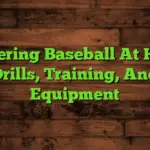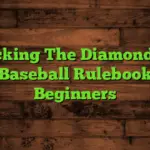Ready to hit home runs and make amazing plays? Learning the fundamentals is key to success in baseball, and that’s where dedicated practice comes in. This guide dives deep into the best baseball drills for beginners, helping you improve your skills and build a strong foundation for the game. We’ll cover everything from throwing and catching to batting and base running, offering detailed instructions and variations to suit your skill level. Get ready to elevate your game!
Baseball, at its core, is a game of skill and precision. Mastering the fundamentals through consistent practice is crucial for players of all ages and skill levels. Drills provide focused, repetitive training, allowing you to hone specific techniques and build muscle memory. Whether you’re aiming to improve your throwing accuracy, increase your batting power, or enhance your
base running speed, dedicated drills are your pathway to success.
Throwing Drills: Building Accuracy and Power
The Basic Throw
Start with the fundamental throwing motion. Focus on a smooth, overhand delivery, using your entire body to generate power. Practice short throws initially, gradually increasing distance as your accuracy improves. Pay close attention to your footwork and follow-through.
Long Toss
Long toss is an excellent drill for developing arm strength and accuracy at greater distances. Start with a partner at a manageable distance, gradually increasing the gap between you as your throwing improves. Maintain proper form throughout.
Wall Ball
Use a wall to practice your throwing accuracy. Stand a few feet away and throw the ball against the wall, catching it on the rebound. This drill helps improve hand-eye coordination and control.
Catching Drills: Enhancing Your Glove Work
Two-Hand Catch
Beginners should focus on developing a reliable two-handed catch. Keep your eyes on the ball, extend your hands towards it, and softly cushion the impact in your glove and body. Practice catching balls thrown at varying speeds and angles.
One-Hand Catch
Once you’re comfortable with two-handed catches, transition to one-handed catches. This will improve your reaction time and glove control. Focus on making quick, smooth adjustments to glove positioning as the ball approaches.
Reaction Drills
Use a partner to throw balls at random locations and speeds. This will improve your hand-eye coordination and your ability to quickly react to unpredictable throws.
Batting Drills: Improving Your Swing Mechanics
Soft Toss
Soft toss is a fundamental batting drill that helps develop proper swing mechanics. Have a partner gently toss balls towards you, allowing you to focus on your swing path and timing. Concentrate on a smooth, level swing that connects with the sweet spot of the bat.
Tee Work
Using a batting tee allows you to focus on your swing without worrying about the pitch location. Practice hitting off the tee for numerous repetitions to perfect your technique and strengthen your swing.
Dry Swings
Performing dry swings without a ball is great for strengthening your muscles and refining your swing mechanics. Focus on your stance, your weight transfer, and the speed and power of your swing.
Base Running Drills: Boosting Your Speed and Agility
Lead-Off Drills
Practice getting a good lead off of first, second, and third base. Start slow and gradually increase your distance from the base. Pay close attention to your positioning and your reaction to the pitch.
Sliding Drills
Sliding is crucial for base running. Practice your sliding technique to avoid injury. Focus on proper form, ensuring a smooth transition from running to sliding and maximizing your chances of reaching the base safely.
Base Stealing Drills
Practice taking off from the base quickly and efficiently. Use drills to enhance your timing and agility. Simulate various situations to develop your ability to anticipate the pitcher’s movements.
Fielding Drills: Mastering Ground Balls and Fly Balls
Ground Ball Fielding
Practice fielding ground balls consistently. Focus on proper footwork, glove positioning, and throwing technique. Work on your ability to charge the ball, field it cleanly, and make quick, accurate throws to your teammates.
Fly Ball Fielding
Get comfortable with fielding fly balls. Practice calling for the ball, judging its trajectory, and getting into the best possible position to make the catch. Communicate with your teammates to avoid collisions.
Double Play Drills
Practice turning double plays smoothly and efficiently. This requires precise communication, accurate throwing, and quick footwork between the infielders. Drills will improve the coordination and timing of the double play.
Infield Drills: Refining Infielder Specific Skills
Shortstop Drills
Shortstops need quick reactions and strong throwing arms. Practice fielding ground balls from various positions and focus on accurate throws to first base. Develop drills that simulate game-like situations.
Second Base Drills
Second basemen need to quickly react and transfer the ball to other positions, often involving turning double plays. Drills should emphasize quick footwork, smooth transitions, and accurate throws.
First Base Drills
First basemen need to develop quick hands for catching throws. Drills involving thrown balls from varying speeds and angles will increase their range and accuracy of catching.
Outfield Drills: Honing Outfield Specific Skills
Catching Fly Balls
Practice catching fly balls from different distances and angles. This requires good judgment of the ball’s trajectory. Develop strategies for positioning based on the distance of the ball and your teammates.
Throwing from the Outfield
Outfielders need strong throwing arms to accurately throw the ball to the infield. Practice throwing from various positions, focusing on the correct throwing mechanics and accuracy.
Route Running
Involving efficient movement across the field to the ball’s location. Practice making quick decisions, assessing the ball’s trajectory, and making the shortest route to intercept the fly ball.
Practice Schedule and Progression
Consistency is key. Aim for regular practice sessions, gradually increasing the intensity and duration as your skills develop. Start with shorter sessions focusing on specific drills, then move towards longer, more comprehensive practices incorporating various drills. Track your progress and adjust your schedule based on your strengths and weaknesses.
Utilizing Technology for Enhanced Practice
Technology can significantly enhance your practice sessions. Apps and software offer detailed analytics on your throwing speed, swing mechanics, and other aspects of your game. Using video analysis, you can identify areas for improvement and track your progress over time. This tech-driven approach helps you optimize your training.
Benefits of Regular Baseball Drills
Regular practice using effective drills translates directly into improved performance on the field. These drills help build muscle memory, improve hand-eye coordination, refine technique, and boost overall athleticism.
Overcoming Common Challenges in Baseball Drills
Beginners might initially struggle with maintaining proper form, achieving consistent accuracy, or developing enough power. Persistent practice and focusing on the fundamentals are key to overcoming these challenges. Consider seeking guidance from experienced coaches or players for personalized feedback and tailored drills.
Comparing Different Baseball Drills
Different drills target different aspects of the game. A well-rounded practice routine should incorporate a mix of throwing, catching, batting, base running, and fielding drills to develop a balanced skillset. Some drills are better suited for warm-ups, while others are more appropriate for focused skill development.
Finding the Right Drills for Your Skill Level
Beginners should prioritize mastering the fundamental drills before moving onto more advanced techniques. Start with simple exercises and gradually increase the complexity as your skills progress. Don’t rush the process. Focus on mastering the basics before tackling more challenging drills.
Frequently Asked Questions
What are the most important baseball drills for beginners?
For beginners, focusing on the fundamentals is crucial. Mastering basic throwing, catching, and batting drills is essential before moving on to more complex techniques. Building a solid foundation in these areas will provide a strong base for future skill development.
How often should I practice baseball drills?
Regularity is key. Aim for at least 2-3 practice sessions per week. The duration of each session can vary based on your fitness level and available time. Short, focused sessions are better than infrequent, long sessions.
How can I improve my throwing accuracy?
Focus on a smooth, overhand throwing motion. Pay close attention to your footwork and follow-through. Practice at different distances, gradually increasing the range as your accuracy improves. Use drills like wall ball to refine your accuracy.
How can I improve my batting power?
Proper swing mechanics are crucial for power hitting. Work on drills like soft toss and tee work to refine your swing path and timing. Focus on generating power from your legs and core, not just your arms.
What are some good resources for learning more about baseball drills?
Numerous online resources, including websites, videos, and apps, provide detailed instructions and demonstrations of various baseball drills. You can also find valuable information in baseball coaching manuals and books.
Final Thoughts
Mastering the fundamentals of baseball requires consistent effort and dedicated practice. By incorporating the best baseball drills for beginners into your training regime, you’ll significantly improve your skills and build a solid foundation for the game. Remember to focus on proper technique, maintain consistent practice, and track your progress. Don’t be afraid to seek guidance from experienced coaches or players. With dedication and the right approach, you’ll be hitting home runs and making incredible plays in no time!





